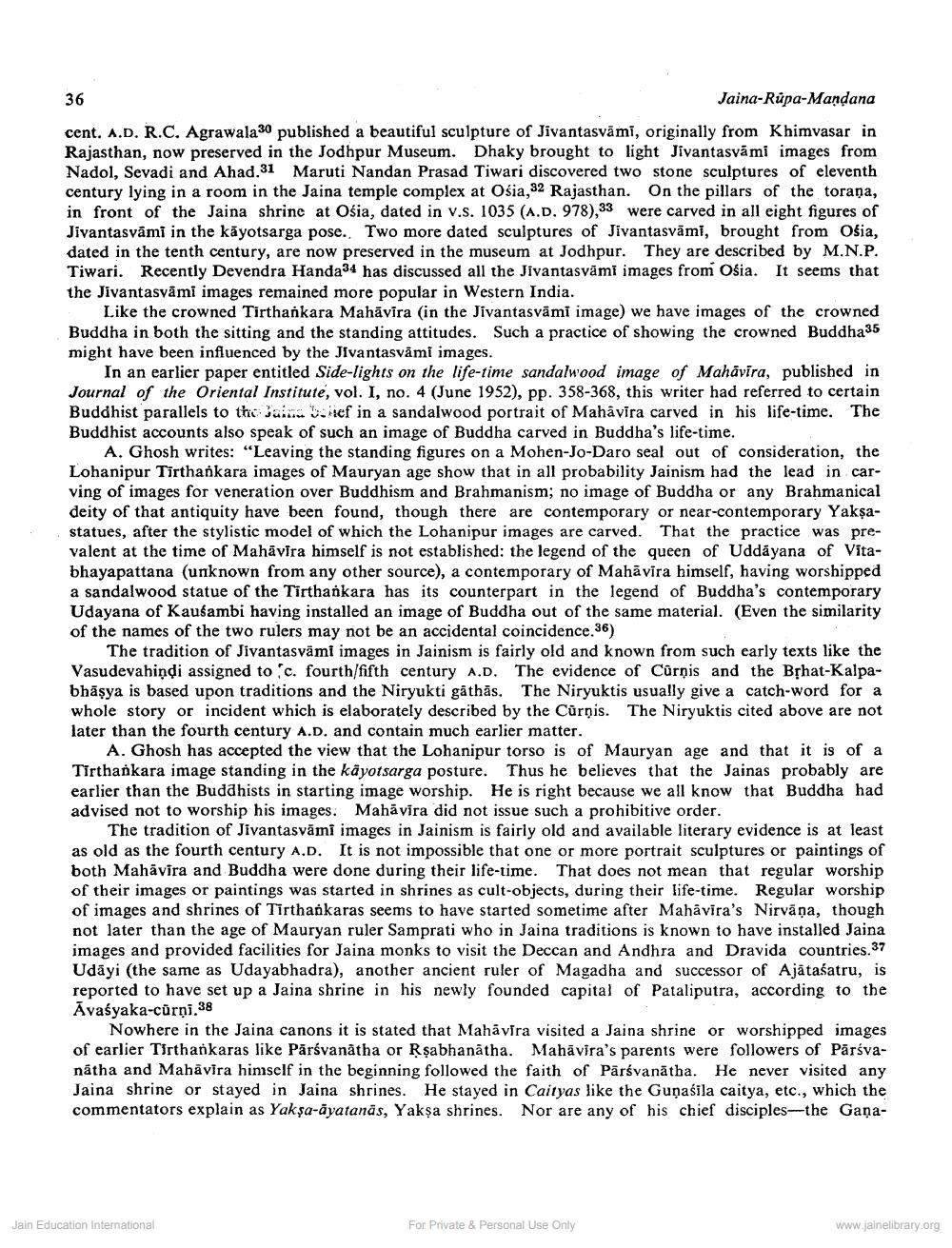________________
Jaina-Rupa-Mandana cent, A.D. R.C. Agrawala 30 published a beautiful sculpture of Jivantasvāmi, originally from Khimvasar in Rajasthan, now preserved in the Jodhpur Museum. Dhaky brought to light Jivantasyami images from Nadol, Sevadi and Ahad.31 Maruti Nandan Prasad Tiwari discovered two stone sculptures of eleventh century lying in a room in the Jaina temple complex at Ośia,32 Rajasthan. On the pillars of the torana, in front of the Jaina shrine at Ośia, dated in v.s. 1035 (A.D. 978),33 were carved in all eight figures of Jivantasvāmi in the kāyotsarga pose. Two more dated sculptures of Jivantasvämi, brought from Osia, dated in the tenth century, are now preserved in the museum at Jodhpur. They are described by M.N.P. Tiwari. Recently Devendra Handa 34 has discussed all the Jivantasväml images from Ośia. It seems that the Jivantasyāmi images remained more popular in Western India.
Like the crowned Tirthankara Mahāvira (in the Jivantasvāmi image) we have images of the crowned Buddha in both the sitting and the standing attitudes. Such a practice of showing the crowned Buddha35 might have been influenced by the Jivantasvāmi images.
In an earlier paper entitled Side-lights on the life-time sandalwood image of Mahavira, published in Journal of the Oriental Institute, vol. I, no. 4 (June 1952), pp. 358-368, this writer had referred to certain Buddhist parallels to the Jaina cf in a sandalwood portrait of Mahavira carved in his life-time. The Buddhist accounts also speak of such an image of Buddha carved in Buddha's life-time.
A. Ghosh writes: “Leaving the standing figures on a Mohen-Jo-Daro seal out of consideration, the Lohanipur Tirthankara images of Mauryan age show that in all probability Jainism had the lead in carving of images for veneration over Buddhism and Brahmanism; no image of Buddha or any Brahmanical deity of that antiquity have been found, though there are contemporary or near-contemporary Yaksastatues, after the stylistic model of which the Lohanipur images are carved. That the practice was prevalent at the time of Mahavira himself is not established: the legend of the queen of Uddá yana of Vitabhayapattana (unknown from any other source), a contemporary of Mahavira himself, having worshipped a sandalwood statue of the Tirthankara has its counterpart in the legend of Buddha's contemporary Udayana of Kausambi having installed an image of Buddha out of the same material. (Even the similarity of the names of the two rulers may not be an accidental coincidence.36)
The tradition of Jivantasvāmi images in Jainism is fairly old and known from such early texts like the Vasudevahiņdi assigned to c. fourth/fifth century A.D. The evidence of Cūrnis and the Bțhat-Kalpabhāşya is based upon traditions and the Niryukti gathās. The Niryuktis usually give a catch-word for a whole story or incident which is elaborately described by the Cūrnis. The Niryuktis cited above are not later than the fourth century A.D. and contain much earlier matter.
A. Ghosh has accepted the view that the Lohanipur torso is of Mauryan age and that it is of a Tirthankara image standing in the käyotsarga posture. Thus he believes that the Jainas probably are earlier than the Buddhists in starting image worship. He is right because we all know that Buddha had advised not to worship his images. Mahavira did not issue such a prohibitive order.
The tradition of Jivantasvāmi images in Jainism is fairly old and available literary evidence is at least as old as the fourth century A.D. It is not impossible that one or more portrait sculptures or paintings of both Mahāvira and Buddha were done during their life-time. That does not mean that regular worship of their images or paintings was started in shrines as cult-objects, during their life-time. Regular worship of images and shrines of Tirthankaras seems to have started sometime after Mahavira's Nirvāņa, though not later than the age of Mauryan ruler Samprati who in Jaina traditions is known to have installed Jaina images and provided facilities for Jaina monks to visit the Deccan and Andhra and Dravida countries.37 Udayi (the same as Udayabhadra), another ancient ruler of Magadha and successor of Ajātaśatru, is reported to have set up a Jaina shrine in his newly founded capital of Pataliputra, according to the Avaśyaka-curņi38
Nowhere in the Jaina canons it is stated that Mahāvīra visited a Jaina shrine or worshipped images of earlier Tirthankaras like Pārsvanātha or Rşabhanātha. Mahāvira's parents were followers of Pārsvanátha and Mahavira himself in the beginning followed the faith of Pärsvanātha. He never visited any Jaina shrine or stayed in Jaina shrines. He stayed in Caityas like the Guņaśila caitya, etc., which the commentators explain as Yakşa-āyatanās, Yaksa shrines. Nor are any of his chief disciples-the Gaņa
Jain Education International
For Private & Personal Use Only
www.jainelibrary.org




